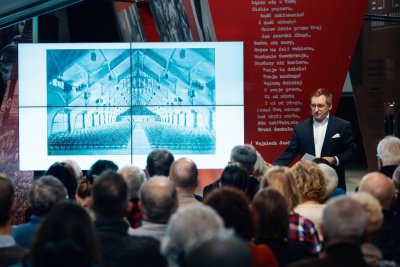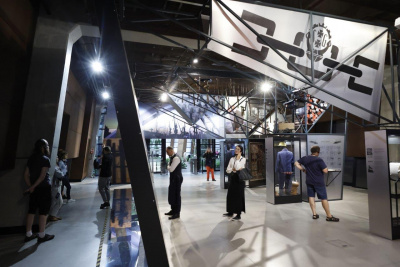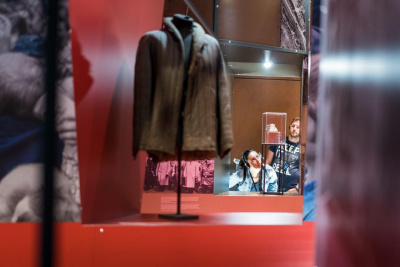A series of lectures entitled 'Hoisting History' has been running since January. Researchers from the University of Gdańsk and beyond are discussing the most exciting moments from the more than 150-year history of the Gdańsk Shipyard at the European Solidarity Centre. And all this is part of the exhibition entitled 'SHIPYARD | Man. Industry. City.'
We talk about the creation of the exhibition, the search for the 'golden mean' and the future of the Shipyard with dr Magdalena Staręga, the content coordinator of the SHIPYARD exhibition, who will give a lecture on February 23 at 18.00 on 'Events, accidents, tragedies. Occupational Safety and Health in the Gdańsk Shipyard in the Communist Era'.
Marcel Jakubowski: - At what point did you decide to organise a series of lectures as such a 'supplement' to the exhibition?
Dr Magdalena Staręga: - The idea came to us after the exhibition had opened, but it arose from a need we felt when creating the exhibition. The exhibition tells the story of 170 years of the shipbuilding industry in Gdańsk - so we had a lot of material at our disposal. When we built the narrative by dressing it up with texts, photographs, objects and archives, we focused on essential issues to make our story accessible and readable for visitors. Thus, we had to give up telling very interesting plots that did not fit within the framework of the setting. The result was a certain unsatisfactory feeling both for us and for our visitors who are interested in Gdańsk and the Shipyard itself. The 'Hoisting History' series is intended to take an even closer look at the history of the Shipyard.

Inaugural lecture of the ‘Hoisting History' series at the ECS. Dr Jan Daniluk presents the topic 'Forced labour and the shipbuilding industry in Gdańsk during World War II', January 26, 2023, photo: Dawid Linkowski | ECS archives
- How did you choose the topics that would be worth expanding on?
- We decided on ten topics that seemed particularly interesting to us and that are in the field of interest of individual researchers. Most of them work at the University of Gdańsk, hence the idea to involve the University as a Project Partner. The speakers will elaborate on the themes presented in the exhibition, which have often not lived to see scientific elaboration. For example, one of dr Jan Daniluk's lectures will be on shipyard workers in the Wilhelminian era and the Free City of Gdańsk. This is an unknown topic, yet at that time, the Gdańsk shipyards were the largest workplaces in the region, and many strikes took place there.
- The lectures and exhibition touch on challenging topics related to the Gdańsk Shipyard that are not discussed daily. What made you choose these events?
- Indeed, in the popular consciousness, the Gdańsk Shipyard is associated with the cradle of Solidarity, the birthplace of Polish freedom. However, in the SHIPYARD exhibition, we did not want to duplicate the themes of the ECS permanent exhibition. Apart from this, topics related to the Gdańsk Shipyard, such as the events of December '70, August '80 or 1988, are widely known and function in academic discourse. We wanted to draw attention to the lesser-known pages of its history and show that its heritage is multi-dimensional. We, therefore, do not avoid telling the story of the Gdańsk shipyards' contribution to building the military might of the German Empire or the forced labour in the Gdańsk shipyards for the Second Reich. In this way, we can show its universal value as a place that symbolises democratic change and, on the other hand, the tragic legacy of both world wars.

The exhibition 'SHIPYARD. Man. Industry. City' at the European Solidarity Centre, photo: Grzegorz Mehring | ECS archives
- The exhibition presents the Gdańsk Shipyard not from the industrial side but from the human side. Why did you decide to adopt this perspective?
- We focus on the human being because this perspective is closest to us. We talk very little about ships and the shipbuilding industry; they are just the background of our history. Each theme presented in the exhibition is told mainly from the perspective of the shipbuilder's experience. Our permanent collection is about well-known heroes. Here, we wanted to tribute to anonymous people whose strength was based on a sense of Solidarity built on daily, joint - Solidarity - work.
- You will discuss these anonymous heroes' working conditions in your forthcoming lecture. What were the health and safety conditions like in the Gdańsk shipyard?
- Let me quote one of the shipyard sociologists who used to say that work in the Shipyard was difficult, dirty and dangerous. Shipbuilding was a highly complex process bringing together many different trades, each creating different working conditions and risks. There were up to a thousand accidents a year in the Shipyard, including several fatalities, and occupational illnesses were not uncommon. During the lecture, I will focus on why and what was done to prevent these incidents. I will also talk about the greatest tragedy in the history of the plant, namely the fire on the general cargo vessel ms 'Konopnicka', which resulted in the deaths of 22 people.

The exhibition 'SHIPYARD. Man. Industry. City’ at the European Solidarity Centre, photo: Michał Mistat | ECS archives
- When did you start working on this exhibition?
- It took several years to create the exhibition, but the Gdańsk Shipyard has been the subject of our interest since the beginning of the ECS. Thanks to the exhibition, we could summarise many years of research on the subject and organise several cultural and social projects. The cooperation with the community of former plant workers, particularly important to us, started in 2014. Today, shipyard workers in their 80s and 90s are a unique community, still very much connected to the plant. They have unique knowledge and materials at their disposal, which we were able to draw on in creating the exhibition.
- What was your role as substantive curator of the exhibition?
- The curatorial team consisted of five people: the director of the ECS—Basil Kerski, and ECS employees—Agnieszka Bacława-Kornacka, dr Kondrad Knoch, Monika Krzencessa-Ropiak and me. What is important is that we have all already collaborated in the creation of the ECS permanent exhibition. As a substantive curator, I contributed a package of knowledge and materials collected over the years, conducted additional searches, and wrote texts. The team's main challenge was to translate this knowledge into the language of the exhibition, to guide the story in such a way that it was clear to the viewer and, at the same time, reflected what we thought was most important. This was the most difficult stage of the work. The exhibition designer Mirosław Miłogrodzki and Karolina Lejczak-Pastuszka, who was responsible for acquiring the objects, also played a significant role in this process. We each had a different perspective on the Shipyard, which was inspiring.
- How did you select the speakers for the 'Hoisting History' series?
- The speakers are specialists in their topics, having researched them for years. Each of them contributes to increasing knowledge of the heritage of the Gdańsk Shipyard. The series is an opportunity to present the results of scientific inquiry. However, the lecture formula is not aimed solely at a narrow circle of specialists but at everyone interested in the history of Gdańsk, including students. We are keen to make the lectures attractive and varied. They have been selected in such a way that they relate to the exhibition's central themes, although they do so to varying degrees.
- Is there a slogan that binds the Shipyard through these 170 years?
- Change. For 170 years, the area has been undergoing dynamic change due to the current political situation. Much of the site that used to be a powerful state-owned industrial facility today cater to other needs of society. A modern district of Gdańsk, the Young City, is emerging here. It is now an entertainment, cultural or residential space attracting thousands. New initiatives are constantly being created here; new places are opening up. We are always dealing with a place full of life, where the shipbuilding industry is still alive, contrary to popular opinion.
